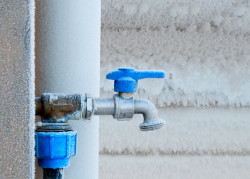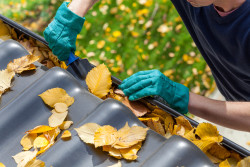
A Chill is in The Air
What a beautiful summer we had. It may have started late but it made up for it with near perfect days. Whether or not you’re looking forward to cooler temperatures, changing leaves and unpredictable schedules, fall reminds us that winter is coming. So as you trade those summer shorts for warm sweaters, make sure your home is prepared for the change of season too.
When the temperature drops, water freezes and expands which can cause serious problems for many homeowners. Damage from burst pipes can cost hundreds, or even thousands of dollars due to flooding, water damage and repairs. Depending on your insurance policy, some of that may not even be covered.
Here are a few things you can do now to prepare your home for what’s coming:
Don’t Forget About Me
Remember to prepare your outside taps for winter. First, turn off the inside shut-off valve for your outside tap. Next, go outside to disconnect and drain your garden hose and put away until  spring. If left connected, the remaining water in the hose will freeze, expand and possibly burst the valve and/or piping. Next, turn on the tap to drain all water and leave it open to prevent pressure build-up during winter. If you have a drain bleeder on your inside valve (small lever or screw cap on side of valve), go back inside and open the drain bleeder to completely drain any remaining water into a container. Close the drain bleeder. (Note: YES, this even applies to non-freeze taps.)
spring. If left connected, the remaining water in the hose will freeze, expand and possibly burst the valve and/or piping. Next, turn on the tap to drain all water and leave it open to prevent pressure build-up during winter. If you have a drain bleeder on your inside valve (small lever or screw cap on side of valve), go back inside and open the drain bleeder to completely drain any remaining water into a container. Close the drain bleeder. (Note: YES, this even applies to non-freeze taps.)
Wrap It Up
Unfortunately, some water piping is located in unheated/cold areas such as the garage, in crawl spaces and attics or near exterior walls in the home, particularly in basements. Protect these pipes by wrapping them in heat tape or foam rubber pipe insulation. For the few times when Arctic-like temperatures hit, turn on both the hot and cold sides of the faucets of susceptible pipes and let the water gently trickle to prevent the pipes from freezing. Open cabinet doors to allow heat in and turn up the thermostat. You may even want to put a portable heater in the area of vulnerable pipes. A few extra dollars spent in heating for a short time could save you thousands in damages should the pipes freeze and burst.
All Pumped Up
Now is a good time to have all your home’s important plumbing systems serviced.
Fall storms and winter melting snow can keep your sump pump working overtime. Test the pump now by pouring two buckets of water into the pit to see if it removes the water. Check the pump for debris and clean out the pit. Regularly check and remove any debris, leaves and ice from the discharge line to prevent flooding. Protect the discharge pipe from freezing. Some homes have longer discharge pipes for the summer which must be shortened at the coupling for winter to prevent freezing.
Your hot water heater also works harder during the cold winter months so it is a good idea to have it serviced before winter. Flushing out the tank to prevent sediment buildup and changing the anode rod to prevent rusting are just two ways to increase efficiency and extend the life of your hot water heater.
If you are on a septic, now is the time to get it pumped out. Make sure the baffles or filters have been cleared of waste and debris to prevent backups. It is recommended by most septic manufacturers to have your septic system serviced by a professional twice annually, typically in spring and fall.
Do Regular Check Ups
If one of your drains is even partially clogged due to hair, grease, leaves or roots, the sitting water freezes then expands, creating a blockage which may burst the pipe. If ANY of your drains seem to be a little slower than usual or there’s gurgling, get them cleared out now to prevent an unwanted emergency later. If you use a garbage disposal, remind everyone not to put down any fat, bones, pasta, rice or stringy vegetables which will clog your drains.
Take It Outside
 Remove all leaves and debris from your eavestroughs, gutters and downspouts. Water that can’t drain away can pool around your home’s foundation and eventually find a way inside. Also, water that is trapped in your eavestroughs may build up under your shingles then freeze and expand, lifting up your shingles. Once it starts to thaw from the heat in your home, the melting water can find its way down through your ceiling and walls causing damage. Many people call their plumber believing it to be a plumbing problem.
Remove all leaves and debris from your eavestroughs, gutters and downspouts. Water that can’t drain away can pool around your home’s foundation and eventually find a way inside. Also, water that is trapped in your eavestroughs may build up under your shingles then freeze and expand, lifting up your shingles. Once it starts to thaw from the heat in your home, the melting water can find its way down through your ceiling and walls causing damage. Many people call their plumber believing it to be a plumbing problem.
And Last But Not Least. . .
Take a minute to show everyone in your home where the main shut off valve is and how to turn it off in case of an emergency.
Plumbing emergencies always seem to happen at the worst time. A little preparation now will save you a lot of heartache (and money) later. If you are not comfortable with performing any of the above, please call a professional.
For a free instructional valve tag for your outside taps, please email us and we’d be happy to mail it out to you!